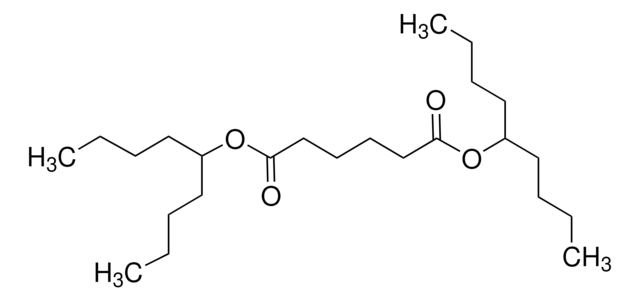84818
Bis(2-ethylhexyl) sebacate
Selectophore™, ≥97.0%
Sinónimos:
Di(2-ethylhexyl) sebacate, Sebacic acid di(2-ethylhexyl) ester, ‘Dioctyl’ sebacate
About This Item
Productos recomendados
grade
for ion-selective electrodes
Quality Level
product line
Selectophore™
assay
≥97.0% (GC)
≥97.0%
form
liquid
refractive index
n20/D 1.450 (lit.)
bp
212 °C/1 mmHg (lit.)
density
0.914 g/mL at 25 °C (lit.)
SMILES string
CCCCC(CC)COC(=O)CCCCCCCCC(=O)OCC(CC)CCCC
InChI
1S/C26H50O4/c1-5-9-17-23(7-3)21-29-25(27)19-15-13-11-12-14-16-20-26(28)30-22-24(8-4)18-10-6-2/h23-24H,5-22H2,1-4H3
InChI key
VJHINFRRDQUWOJ-UHFFFAOYSA-N
¿Está buscando productos similares? Visita Guía de comparación de productos
General description
Application
Legal Information
Storage Class
10 - Combustible liquids
wgk_germany
awg
ppe
Eyeshields, Gloves
Elija entre una de las versiones más recientes:
¿Ya tiene este producto?
Encuentre la documentación para los productos que ha comprado recientemente en la Biblioteca de documentos.
Los clientes también vieron
Nuestro equipo de científicos tiene experiencia en todas las áreas de investigación: Ciencias de la vida, Ciencia de los materiales, Síntesis química, Cromatografía, Analítica y muchas otras.
Póngase en contacto con el Servicio técnico









![Sodium tetrakis[3,5-bis(trifluoromethyl)phenyl]borate Selectophore™](/deepweb/assets/sigmaaldrich/product/structures/251/439/7a621e74-bfd1-4a43-833c-09adfcc1e0b3/640/7a621e74-bfd1-4a43-833c-09adfcc1e0b3.png)
